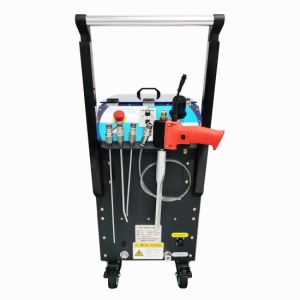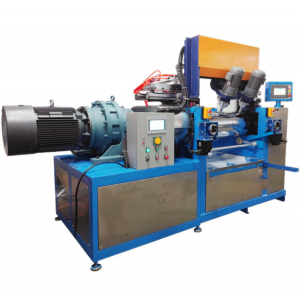Film blowing machine is a kind of equipment used to produce plastic film, which is widely used in packaging, agriculture and industry. Its basic working principle is to heat and melt plastic particles, extrude them through the die head and use the airbag device to expand them to form a film. The main components of the film blowing machine include extruder, die head, cooling system and winding device. It can adjust the thickness, width and performance of the film according to the needs to adapt to the needs of different markets. It is worth mentioning that modern film blowing machines can adjust the thickness, width and performance of the film according to different needs to adapt to the specific needs of different markets. In addition, modern film blowing machines usually have advanced features such as high efficiency, automatic control and energy-saving design, which significantly improves the quality and efficiency of production.
Principle steps of film blowing machine:
The film blowing machine consists of an extruder: a die, an airbag device, a cooling system, a winding device, and a control system. Its operating process is as follows:
Raw material feeding: Plastic particles (such as polyethylene, polypropylene, etc.) enter the extruder through a feeding device.
Melting extrusion: In the extruder, the plastic particles are heated to a molten state and extruded through the rotation of the screw to form a molten plastic flow.
Die head molding: The molten plastic flow passes through the die head to form a uniform tubular film.
Gas inflation: Air is introduced through the center of the die head to expand the tubular film outward to form the required film thickness and width.
Cooling and shaping: The expanded film passes through a cooling device to quickly solidify and maintain its shape.
Winding: The solidified film is rolled into a roll for subsequent processing and use.
This process can produce plastic films of various thicknesses and widths, suitable for different application scenarios.
Application of film blowing machine
Packaging industry: used to produce food packaging, shopping bags, express bags, cling film, etc.
The role of film blowing machines in the packaging industry is very important. Food packaging: producing transparent cling film, vacuum packaging film, etc., can extend the shelf life of food and reduce waste. Industrial packaging: manufacturing plastic films for industrial products, such as packaging machinery parts, electronic products, etc., to protect products from the external environment. Daily necessities packaging: producing disposable shopping bags, garbage bags, cleaning films, etc., for consumers to use. Special functional films: such as moisture-proof films, anti-ultraviolet films, degradable films, etc., to meet specific packaging needs.
Agriculture: used to make agricultural films, ground films and greenhouse films, which help to increase crop yields and protect plants. Ground films are used to cover the soil, helping to maintain soil temperature, reduce water evaporation and inhibit weed growth, thereby increasing crop yields. Greenhouse films are used to make greenhouse films, providing a suitable growth environment, enhancing light and heat preservation effects, and promoting plant growth. Seedling films are used as covering films for seedling trays to ensure humidity and temperature during seedling cultivation, which helps to increase the survival rate of seedlings. Agricultural plastic bags, such as fertilizer bags and harvest bags, are convenient for farmers to use during planting and harvesting. Insect-proof films: films used for insect control are made to effectively reduce the use of pesticides and protect crop safety.
Industrial: Production of industrial films such as waterproof films, thermal insulation films and protective films. Waterproof films: Used in the construction industry to protect structures from moisture and enhance durability. Thermal insulation films: Used in the production of thermal insulation materials to help save energy and improve environmental comfort. Protective films: Used to protect electronic products, mechanical parts, etc. to prevent scratches and contamination. Packaging films: Manufacture of industrial packaging films, suitable for safe packaging of mechanical parts and chemical products. Special functional films: Such as antistatic films, flame retardant films, etc., to meet specific industrial needs.
Daily necessities: used to manufacture garbage bags, disposable tableware films, sanitary product packaging, etc. Shopping bags: produce lightweight plastic shopping bags, which are widely used in supermarkets and stores. Garbage bags: manufacture garbage bags of various specifications to facilitate daily garbage disposal, with the characteristics of durability and leak-proof. Disposable tableware films: used to package disposable tableware, such as lunch boxes, cups, etc., to ensure hygiene and convenience. Food packaging: produce disposable food packaging films, suitable for take-out, fast food, etc., to ensure the safety and freshness of food. Medical products: manufacture disposable gloves, infusion bags and other medical supplies to ensure sterility and safety. Medical field: used for medical packaging, infusion bags, disposable gloves, etc.
The film blowing machine has the following notable features
High efficiency: It can quickly produce large-format films and improve production efficiency.
Excellent film quality: Through reasonable temperature control and cooling, it can produce films with high transparency and uniform thickness.
Flexibility: The thickness, width and performance of the film can be adjusted according to demand to adapt to different product requirements.
Energy saving: Modern film blowing machines usually adopt energy-saving design to reduce energy consumption and production costs.
Automation control: Equipped with advanced control systems to achieve automatic monitoring and adjustment, reduce manual intervention, and improve production stability.
Multiple raw material adaptability: It can process a variety of plastic raw materials, such as PE, PP, PVC, etc., to meet different market needs.
 +86 18030169616
+86 18030169616 allen@crtopmachine.com
allen@crtopmachine.com










